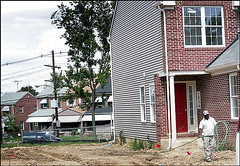Two lessons about the Comp Plan and policy in one Post article
Why the Comp Plan needs to stress quality. And why all District Government agencies should be required to make decisions in terms of the directives of the Comp Plan...
Today's Post has a front page story, "High Hopes, and Higher Home Prices," subtitled "In Anacostia Development Is Part Of Plan to Diversify, Mend Worn D.C. Area," about building upscale housing in the Anacostia neighborhood, in part with city-provided funds to increase economic diversity in that lower-income neighborhood.
I don't necessarily have a problem with using municipal funds in such a manner, but...
1. If you're going to build housing with municipal and/or federal government subsidies, at least make sure that the housing is constructed at a high level of quality. From the photo below, I would aver that the use of siding rather than brick is a value-engineering choice that is out-of-context with the traditional and historic housebuilding practices in that neighborhood. In short, either build with all brick or all siding (frame), but don't mix the two. For more about Anacostia's architectural history, go to the Washingtoniana Collection at the Martin Luther King library and read Anacostia Conserved, which was published by DHCD in 1979.
 Melina Mara -- The Wasington Post Photo
Melina Mara -- The Wasington Post PhotoAs I quoted yesterday, from Public Buildings: American Images:
And, not surprisingly, Thomas Jefferson observed that: "How is a taste in [the] beautiful art [of architecture] to be formed in our countrymen unless we avail ourselves of every occasion when public buildings are to be erected of presenting to them models for their study and imitation?"
Outstanding quality should be the foremost concern of every building project in DC, but especially of any building project involving funds provided by the DC Government.
2. I am not too fond of this quote from Leo Clarke, special projects coordinator at the D.C. Department of Housing and Community Development. Well, I guess I should say that he gets it half right...
"We're trying to encourage investment in an otherwise blighted area."
As readers know, from time to time I write about what I call "the language of revitalization." The real issue is disinvestment. What people call "blight" is a result of disinvestment. Rather than blame the place (I call this "blaming the building"), focus on disinvestment and explain the process. Too often people are lulled into believing that demolition, especially of historic buildings, is a solution to "blight" when merely it creates a different form of blight, one that is harder and more expensive to correct (building a new building).

As I mentioned in another blog post, "Is this the fifth phase of center city revitalization? (since World War II)," Alan Mallach, author of the book Bringing Buildings Back, gave a whole presentation on disinvestment and restoring buildings in weak real estate markets without once using the word "blight." He focuses on the disinvestment process and how to right it...
Here's something I wrote about "blaming the building," back in March:
I'll admit, the deplorable condition of the MLK Library had me falling into the same "blaming the building" trap that I frequently accuse others of suffering from...Buildings or neighborhoods called dilapidated, run-down, blight, eyesores, nuisances, decrepit, (etc.) are victims (and survivors) of disinvestment.
The solution is not demolition, but investment instead of disinvestment. And maintenance and/or rehabilitation is the proper response to neglect or demolition-by-neglect.
Index Keywords: urban-revitalization



0 Comments:
Post a Comment
<< Home